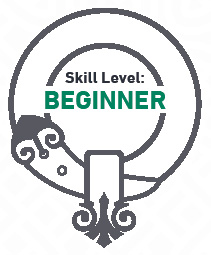
Finished sizes: Table runner: 24¼˝ × 51¼˝ ♦ Square lap quilt: 51¼˝ × 51¼˝ ♦ Square twin quilt: 78¼˝ × 78¼˝
MacRae of
Conchra

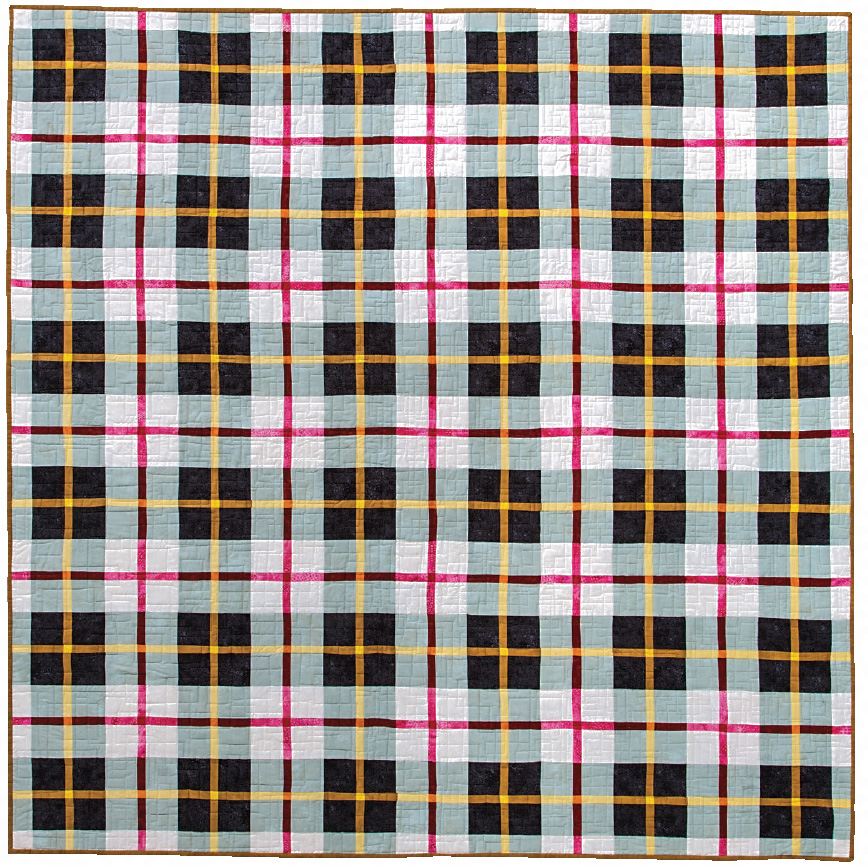
MacRae of Conchra square twin quilt, 78¼˝ × 78¼˝, made by Kathy Allen, quilted by Shannon Ryan-Freeman, 2016
The black/white merge in this traditionally colored quilt is a mint green that reads gray when combined with the other fabrics.
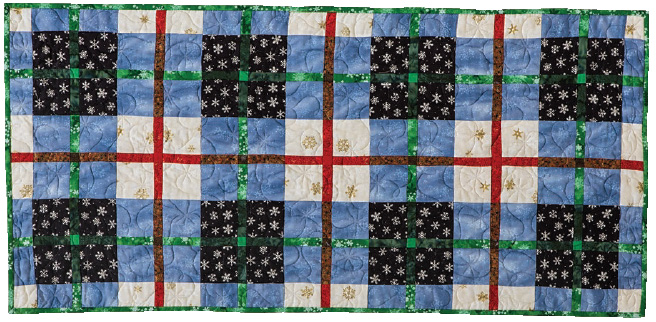
MacRae of Conchra table runner, 24¼˝ × 51¼˝, made by Kathy Allen, quilted by Shannon Ryan-Freeman, 2016
In this Christmas-themed table runner, the white base has been replaced with green, making thin stripes of red and green that intersect the main colors of white, gray, and black (all snowflake and star patterns).
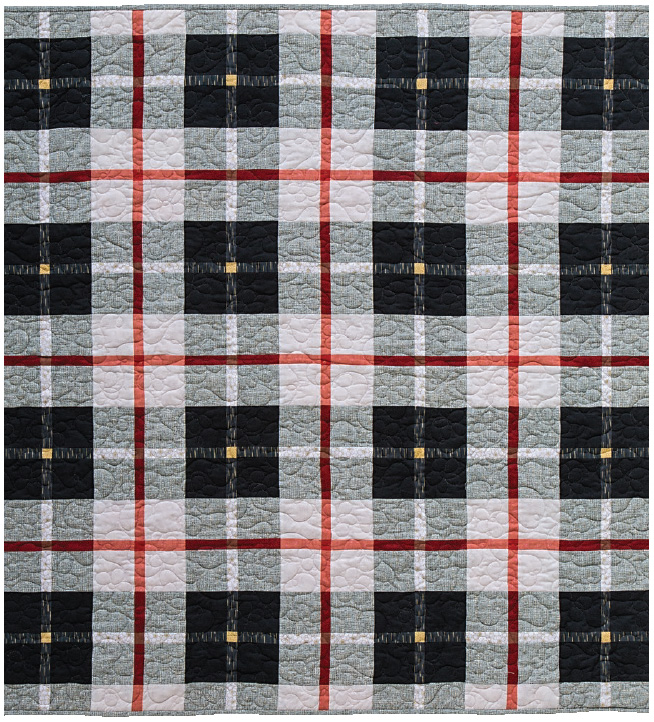
MacRae of Conchra square lap quilt, 51¼˝ × 51¼˝, made by Kathy Allen, quilted by Shannon Ryan-Freeman, 2016
The neutral black, white, and gray are bisected by a thin red stripe. This quilt is true to the traditional colors of the MacRae of Conchra tartan. The use of Asian fabrics gives this quilt a subtle texture compared to those made with solid fabrics.

Eilean Donan Castle, located on an island in Loch Duich, was first built in the thirteenth century. It was the stronghold of the MacKenzies, and Clan MacRae served as constables. After the failed Jacobite uprising of 1719, the castle was held by the Spanish and was destroyed. By 1912, it was nothing but a pile of masonry. Then in 1911 John MacRae-Gilstrap purchased the castle, intending to preserve the ruins. Farquhar MacRae, a local stone mason, was hired to clear the site. When MacRae-Gilstrap returned from World War I, he found that Farquhar was in the process of restoring the castle, claiming he had seen what it originally looked like in a dream. John agreed to a full restoration of Eilean Donan Castle, and in 1932 it was complete. The castle opened to the public in 1955, thanks to the MacRaes of Conchra.
More than sixteen tartans are associated with Clan MacRae. My interpretation of the MacRae of Conchra tartan is a black-and-white pattern with thin stripes of red and yellow dissecting the larger squares. Although similar to the common tartan, the dissecting lines distinguish it. The more traditional MacRae of Conchra has dark blue instead of black.
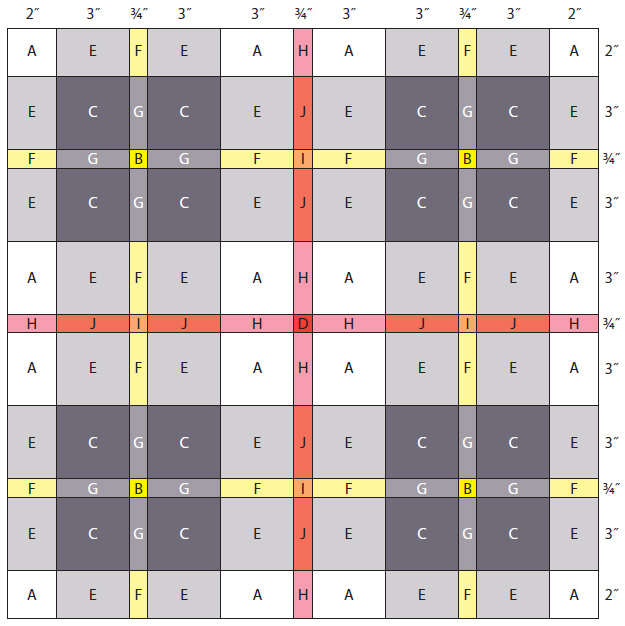
A single woven pattern in my interpretation of the MacRae of Conchra tartan. The MacRae quilts are created by repeating this pattern. The white (fabric A) is intersected by black (fabric C) to create the white/black merge (fabric E) in a checkered pattern. Thin stripes of red (fabrics D, H, and J) and yellow (fabrics B, F, and G) intersect through the black, white, and white/black merge blocks.
Materials
Yardages are listed for the table runner / square lap quilt / square twin quilt.
White (A): ½ yard / ¾ yard / 1⅝ yards
Yellow (B): ⅛ yard / ⅛ yard / ⅛ yard
Black (C): ½ yard / ¾ yard / 1½ yards
Red (D): ⅛ yard / ⅛ yard / ⅛ yard
White/black merge (E): ⅞ yard / 1⅜ yards / 3 yards
Yellow/white merge (F): ½ yard / ½ yard / ⅝ yard
Black/yellow merge (G): ⅜ yard / ½ yard / ¾ yard
White/red merge (H): ½ yard / ½ yard / ⅝ yard
Yellow/red merge (I): ⅛ yard / ⅛ yard / ⅛ yard
Black/red merge (J): ⅜ yard / ½ yard / ⅝ yard
Backing: 1¾ yards / 3½ yards / 7¼ yards (Note: If the usable fabric width is at least 44˝, 5 yards will be enough for the square twin backing.)
Binding: ½ yard / ½ yard / ¾ yard (Black/red merge or white/red merge looks very good as the binding.)

Fabric Selection The pattern of MacRae will show up better if fabric E, which will be the dominant fabric in this pattern, is a medium value that blends fabrics A and C. The fabrics that make up the thin stripe that intersects fabric A (fabrics D, H, I, and J), should be related to give a continuous color. In the sample, the fabrics are in the red family, which pops against the black and white fabrics. The fabrics that make up the thin stripe that intersects fabric C (fabrics B, F, and G) should also be related in color but more subtle. The differences in the two thin stripes will build the design.

Cutting
Cut all strips across the width of fabric. These strips will be used to create triple-strip sets and connectors. See How to Build a Tartan Design for detailed instructions. Put a swatch of each fabric on the fabric organization worksheet to help you keep your fabrics in order.
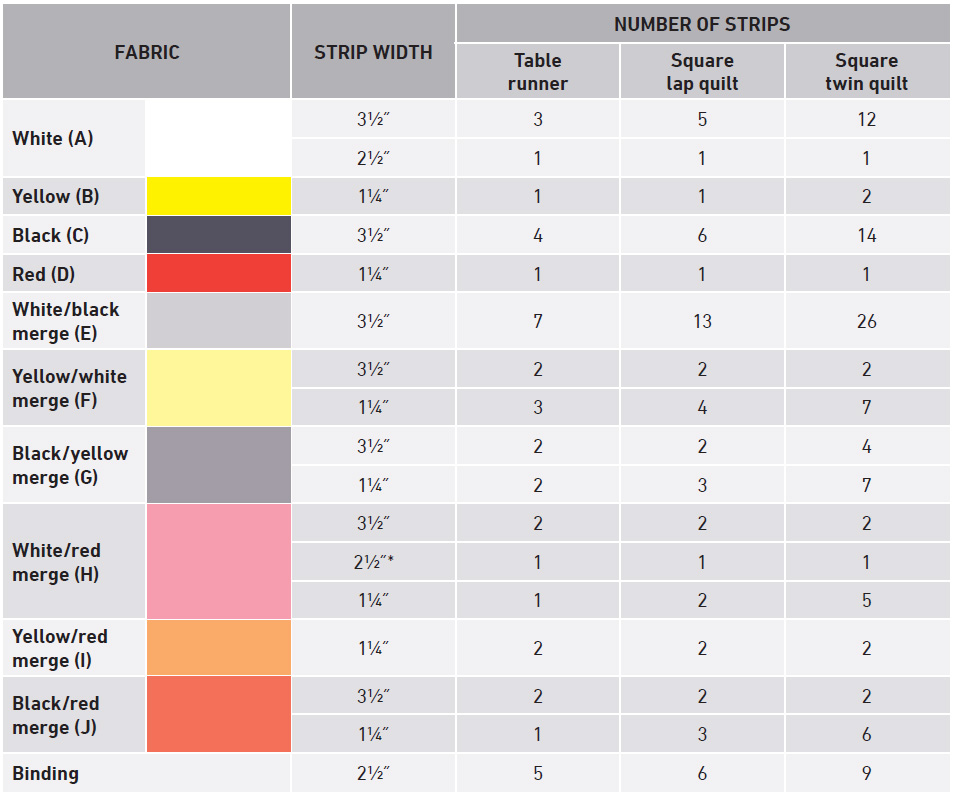
* For connectors only
Making the Quilt
Triplets and Connectors
Refer to the following lists to make strip sets from three fabrics for triple-strip sets. From the strip sets, subcut triplets.
Triplets
TRIPLE-STRIP SET 1
Make 2 strip sets for the table runner, 3 for the square lap quilt, or 6 for the square twin quilt. Subcut triplets 1 and 4.
Note: If the usable width of fabric is only 40˝, an additional strip set may be needed for the square twin quilt.
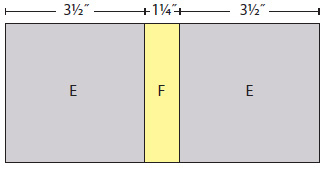
Table runner
Triplet 4: 12 segments 3½˝ wide
Triplet 1: 4 segments 2½˝ wide
Square lap quilt
Triplet 4: 24 segments 3½˝ wide
Triplet 1: 8 segments 2½˝ wide
Square twin quilt
Triplet 4: 60 segments 3½˝ wide
Triplet 1: 12 segments 2½˝ wide
TRIPLE-STRIP SET 2
Make 2 strip sets for the table runner, 3 for the square lap quilt, or 7 for the square twin quilt. Subcut triplet 2.
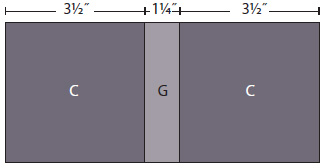
Table runner
― Triplet 2: 16 segments 3½˝ wide
Square lap quilt
― Triplet 2: 32 segments 3½˝ wide
Square twin quilt
― Triplet 2: 72 segments 3½˝ wide
TRIPLE-STRIP SET 3
Make 1 strip set for the table runner or the square lap quilt or 2 for the square twin quilt. Subcut triplet 3.
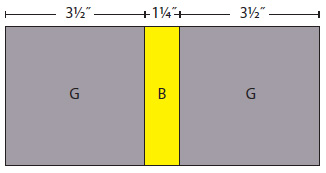
Table runner
― Triplet 3: 8 segments 1¼˝ wide
Square lap quilt
― Triplet 3: 16 segments 1¼˝ wide
Square twin quilt
― Triplet 3: 36 segments 1¼˝ wide
TRIPLE-STRIP SET 4
Make 1 strip set for any project size. Subcut triplet 5.
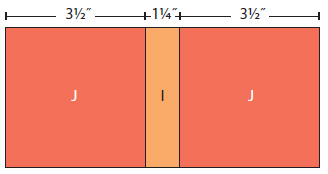
Table runner
― Triplet 5: 6 segments 1¼˝ wide
Square lap quilt
― Triplet 5: 12 segments 1¼˝ wide
Square twin quilt
― Triplet 5: 30 segments 1¼˝ wide
TRIPLE-STRIP SET 5
Make 1 strip set for the table runner, 2 for the square lap quilt, or 5 for the square twin quilt. Subcut triplets 6 and 9.
Note: If the usable width of fabric is only 40˝, an additional strip set may be needed for the square twin quilt.
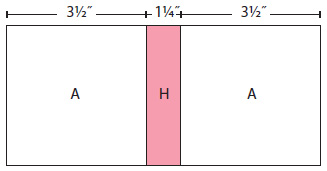
Table runner
Triplet 9: 6 segments 3½˝ wide
Triplet 6: 2 segments 2½˝ wide
Square lap quilt
Triplet 9: 18 segments 3½˝ wide
Triplet 6: 6 segments 2½˝ wide
Square twin quilt
Triplet 9: 50 segments 3½˝ wide
Triplet 6: 10 segments 2½˝ wide
TRIPLE-STRIP SET 6
Make 1 strip set for the table runner, 3 for the square lap quilt, or 6 for the square twin quilt. Subcut triplet 7.
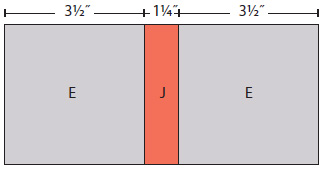
Table runner
― Triplet 7: 8 segments 3½˝ wide
Square lap quilt
― Triplet 7: 24 segments 3½˝ wide
Square twin quilt
― Triplet 7: 60 segments 3½˝ wide
TRIPLE-STRIP SET 7
Make 1 strip set for any project size. Subcut triplet 8.
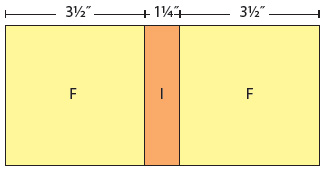
Table runner
― Triplet 8: 4 segments 1¼˝ wide
Square lap quilt
― Triplet 8: 12 segments 1¼˝ wide
Square twin quilt
― Triplet 8: 30 segments 1¼˝ wide
TRIPLE-STRIP SET 8
Make 1 strip set for any project size. Subcut triplet 10.

Table runner
― Triplet 10: 3 segments 1¼˝ wide
Square lap quilt
― Triplet 10: 9 segments 1¼˝ wide
Square twin quilt
― Triplet 10: 25 segments 1¼˝ wide
Connectors
Subcut connectors from the strips left over after you have made the strip sets.
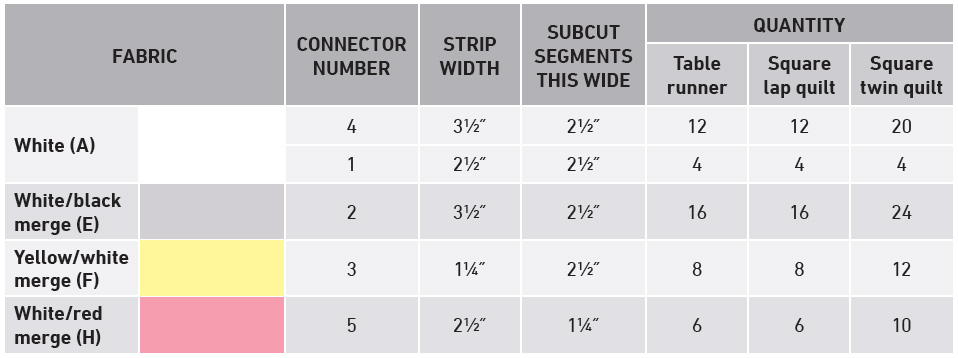

Palindromes The triplets and rows of MacRae are all palindromes (reading the same forward and backward), so you don’t have to be careful about how you sew them into the rows. But recheck the seam allowances in each row to be sure they are all pointed the same way, in alternating directions from row to row.
Making the Rows
Referring to the Row Types table for your quilt size (below), sew the triplets and connectors together to make each type of row. To sew each row together, start with the piece listed at the left and add each segment in order from left to right. The numbers in each column refer to the triplet or connector number you made in Triplets and Connectors. Refer to How to Build a Tartan Design, Step 5 for detailed instructions on how to assemble the rows.

Triplet 4 and Triplet 7 These triplets are very close in appearance. Be careful not to mix them up!
Row Types—Table Runner

Row Types—Square Lap Quilt
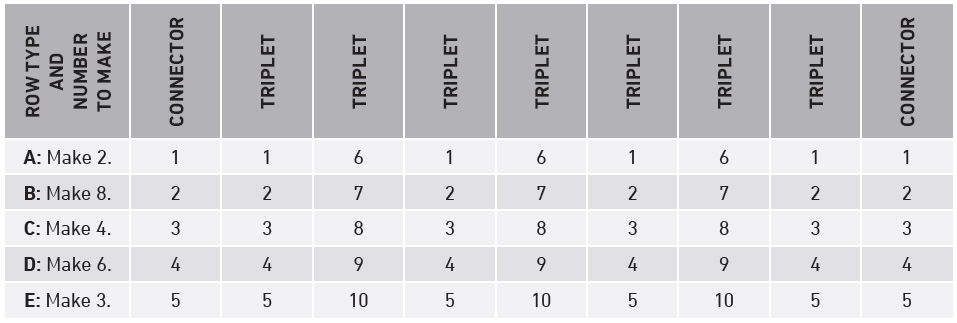
Row Types—Square Twin Quilt
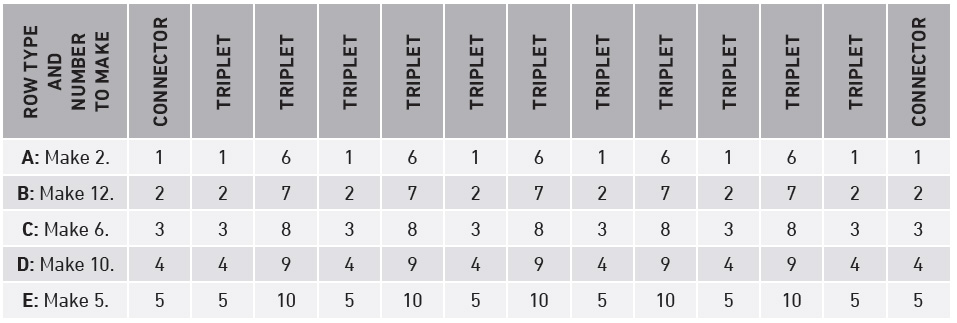
Quilt Assembly
Referring to the quilt assembly diagrams, sew the row types together in the indicated order to complete the quilt top. Press the seam allowances of each row in the opposite direction from adjacent rows. Pin at each and every seam intersection.

Table runner assembly
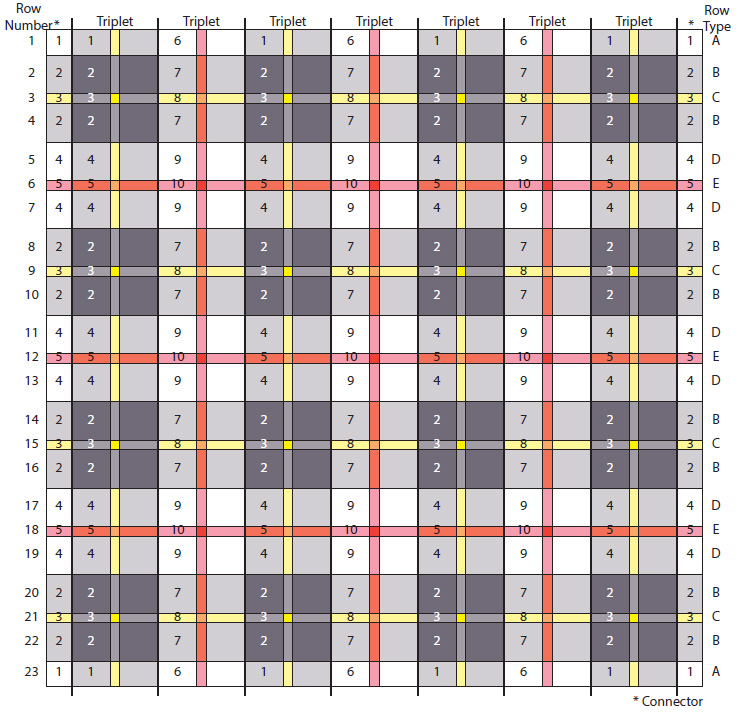
Square lap quilt assembly

